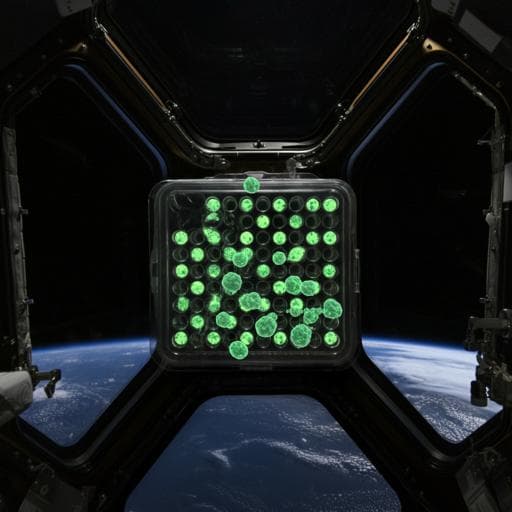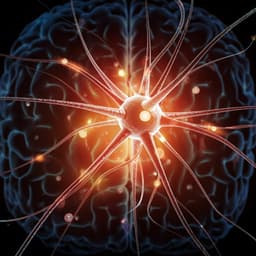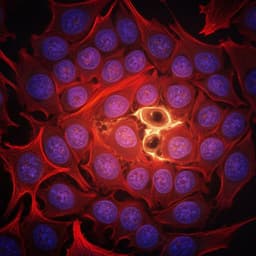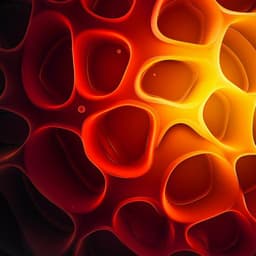
Space Sciences
Surface tension enables induced pluripotent stem cell culture in commercially available hardware during spaceflight
M. Mozneb, M. Arzt, et al.
This groundbreaking research, conducted by a team of experts including Maedeh Mozneb and Peggy A. Whitson, explores the effects of microgravity on human induced pluripotent stem cells and their derivatives, providing a foundation for future biomanufacturing experiments in space.
~3 min • Beginner • English
Introduction
The study investigates whether standard, commercially available 96-well culture plates leveraging surface tension can support human induced pluripotent stem cell (hiPSC) and hiPSC-derived fibroblast culture and transfection in microgravity, and how microgravity affects pluripotency, growth mode (2D adhesion versus 3D spheroid formation), and DNA delivery efficiency. Prior work in low Earth orbit (LEO) and simulated microgravity shows altered differentiation capacity, viability, proliferation, and mechanotransduction across multiple stem cell types, with potential implications for biomanufacturing. However, reproducible, standardized studies with hiPSCs are limited, and most space experiments use custom low-throughput hardware. The authors aim to demonstrate feasibility and performance of hiPSC culture, spheroid formation or adhesion, and lipofection-based plasmid transfection using off-the-shelf 96-well plates during the Ax-2 mission aboard the ISS, thereby enabling higher-throughput, lower-cost, and more reproducible space-based stem cell workflows.
Literature Review
- Prior microgravity studies suggest changes in differentiation capacity, viability, and proliferation of progenitors derived from pluripotent cells and other stem cells, with potential benefits for biomanufacturing and disease modeling. Examples include altered developmental stage and long-term culture feasibility for hiPSC-derived cardiomyocytes in space; enhanced proliferation in neural stem cells, mouse embryonic stem cells, and cardiac progenitors; and mixed evidence on whether microgravity enhances differentiation of specialized lineages.
- Mechanistic insights point to microgravity-driven alterations in mechanotransduction, reduced mechanical loading, and potential epigenetic changes (e.g., DNA methylation, chromatin structure) that could modulate differentiation and pluripotency. Simulated and real microgravity have been associated with reduced requirement for LIF in mouse ESCs, maintenance of pluripotency with inhibited differentiation, and impaired DNA repair and immune differentiation in hematopoietic stem/progenitor cells.
- hiPSCs are central to modern disease modeling, drug screening, and cell therapy, yet the impact of spaceflight on their production, maintenance, and differentiation remains underexplored. Key parameters include growth rate, genomic stability, reprogramming yield, and pluripotency state.
- Non-viral DNA delivery (lipofection) is important for transient expression, genome editing, and reprogramming. Some evidence indicates increased nucleic acid uptake in LEO, potentially due to altered fluid dynamics, enhanced surface tension-driven contact time, or membrane biophysical changes.
- Hardware considerations: most microgravity cell culture has relied on custom, sealed, low-throughput devices optimized for gas exchange and containment. Off-the-shelf polystyrene 96-well plates could lower cost and increase throughput and reproducibility if surface tension can retain media in wells in microgravity.
Methodology
Study setting: Axiom Mission 2 (Ax-2) aboard the International Space Station (ISS), May 2023. A custom SOX2-GFP hiPSC line (nuclear GFP under SOX2 promoter) and hiPSC-derived fibroblasts were prepared on Earth, cryopreserved, launched frozen, and handled on-orbit by astronauts.
- Experimental timeline: 5-day condensed protocol. Day 0: thawing and seeding; Days 1–4: imaging; Day 2 (hiPSCs) and Day 1 post-seeding (fibroblasts): transfection; limited media exchange on Day 2.
- Ground preparation and EVT: BioServe facilitated an Experimental Verification Test at Cedars-Sinai using flight-identical materials to plan timings, astronaut tasks, and equipment handling.
- Cell culture (Earth): SOX2-GFP hiPSCs maintained at 37 °C, 5% CO2 in mTeSR Plus on Matrigel (1:200 of 50 µg/mL), passaged every 3–4 days with 0.5 mM EDTA; routine mycoplasma testing. hiPSC-derived fibroblasts produced using a chemically defined protocol involving CHIR99021 (8–12 µM) days 0–2 in RPMI/B27 minus insulin, RPMI/B27 minus insulin days 2–3, Wnt-C59 at day 3 for days 3–5, then EGM2 with 25 ng/mL FGF-basic changed every 2 days to day 12.
- Cryopreservation: hiPSCs lifted with EDTA, pelleted, and frozen at 500,000 cells in 0.5 mL CryoStor CS10 per cryovial; hiPSC-fibroblasts at 1,000,000 cells in 0.5 mL CryoStor CS10 per cryovial. Vials pre-wrapped with Velcro; initial -80 °C then liquid nitrogen storage pre-flight.
- Launch kit and hardware: Nunc MicroWell 96-well flat-bottom black, clear-bottom plates (Thermo Fisher 165305) pre-coated (first 6 wells per plate) with Matrigel (1:200 of 50 µg/mL), stored at -80 °C in vented Bitran bags. Two frozen vials per cell type launched at -80 °C. Pre-filled syringes and tubes for media/transfection stored at 4 °C; kits included pipettes, tips, plate holders, and containment per NASA Biosafety 2 regulations.
- On-orbit seeding (LSG/SABL): Matrigel plates thawed and equilibrated in SABL (37 °C, 5% CO2). Vials thawed in a 43 °C pouch; CryoStor neutralized with 1 mL cell-type specific media; centrifuged 400 rcf 5 min, supernatant removed (1.2 mL), media restored (1.2 mL), repeat; final resuspension 1 mL. Seeding at 100 µL per well: hiPSCs ~41,000 cells/well (two plates S/N1, S/N2, 6 wells each); hiPSC-fibroblasts ~83,000 cells/well (one plate S/N4, 6 wells). Media compositions: hiPSC feeding medium mTeSR Plus + 1% Antibiotic-Antimycotic + 10 µM ROCK inhibitor; fibroblast medium Advanced DMEM/F-12 + 1% Antibiotic-Antimycotic + 20% FBS + 25 ng/mL FGF-basic + 10 µM ROCK inhibitor. Breathe-Easy sealing film applied under lids for containment.
- Transfection: Due to scheduling, hiPSCs transfected on Day 2 post-seeding; fibroblasts on Day 1 post-seeding. For each plate: first 3 wells received full 100 µL transfection media exchange; last 3 wells received 50 µL top-up to 150 µL total volume to preserve spheroids. Transfection cocktail per 700 µL Opti-MEM: 14 µL Lipofectamine Stem + 7 µL MISSION pLKO.1-puro-CMV-TagRFP plasmid DNA (first 3 wells) or double concentrations (28 µL Lipofectamine, 14 µL DNA) for 50 µL additions to maintain equivalent final concentrations.
- Media exchange: hiPSC plate S/N1 received on Day 2: 100 µL full exchange for first 3 wells and 75 µL half-exchange for last 3 wells with mTeSR Plus + 1% Antibiotic-Antimycotic.
- Imaging: On-orbit Keyence Research Microscope Testbed (KERMIT), BZ-X810 microscope, 10X/20X, phase, GFP, RFP channels. hiPSC plates imaged Day 1; S/N1 further imaged Days 2–4; fibroblast plate S/N4 imaged Days 1–2. Breathe-Easy film left in place during imaging.
- Immunocytochemistry (Earth validation): OCT4 primary antibody to confirm pluripotency marker co-localization with SOX2-GFP.
- Data analysis: Fluorescent intensities (GFP, RFP) normalized to exposure times using Day 1 images as reference; reported as intensity per µm². Pluripotency quantified as normalized GFP per single cell; statistics reported as mean ± SD. Statistical tests included Kruskal–Wallis (one-way ANOVA), Welch’s two-tailed t-test, and 2-way ANOVA with Tukey’s multiple comparisons (alpha 0.05, 95% CI).
Key Findings
- Feasibility: Standard, off-the-shelf 96-well plates successfully retained media in microgravity via surface tension, enabling thawing, seeding, culture, media exchange, imaging, and transfection of hiPSCs and hiPSC-derived fibroblasts on ISS.
- hiPSC morphology and growth: In microgravity, hiPSCs rapidly formed symmetrical spheroids by Day 1 post-seeding, remained in suspension, and some adhered to Matrigel by Day 2. SOX2-GFP expression remained strong, indicating maintained pluripotency. Earth controls remained 2D adherent.
- hiPSC transfection: Lipofectamine-based transfection of an RFP plasmid succeeded both on Earth and in space. Quantification per well showed: GFP intensity per well decreased in space samples from Day 1 to Day 2, contrasting with an increase on Earth; Tukey’s test significance for GFP per well: Day 2 P=0.0032, Day 3 P=0.0041, Day 4 P<0.0001. RFP intensity per well post-transfection was significantly lower in space vs. Earth on Days 3 and 4 (both P<0.0001). Single-cell analyses showed significant differences in SOX2-GFP intensity per cell (Day 2 p=0.0011; Day 3 P<0.0001) and a slight, non-significant increase in transfection efficacy on orbit compared to ground.
- hiPSC-fibroblasts: After seeding in space, cultures exhibited mixed 2D adhesion and 3D spheroid formation by Day 1; successful lipofection with RFP plasmid was confirmed by Day 2 post-transfection. Quantified RFP intensity per unit area showed a significant difference between Earth and space (P=0.033). Transfection efficacy also differed significantly between conditions (P=0.0004).
Discussion
The findings demonstrate that surface tension in commercially available 96-well plates can counteract fluid movement in microgravity, enabling routine hiPSC and hiPSC-derived fibroblast culture operations without custom microgravity hardware. In microgravity, hiPSCs spontaneously aggregate into spheroids—consistent with prior observations in other cell types—yet can subsequently adhere to extracellular matrix (Matrigel) under certain conditions (e.g., presence of ROCK inhibitor, plate movement), yielding a combined suspension/adherent culture mode. Robust SOX2-GFP signal supports preserved pluripotency over the short culture duration. Successful lipofection-based plasmid delivery in both hiPSCs and fibroblasts on orbit, with slight, non-significant increases in hiPSC transfection per-cell efficacy and significant differences for fibroblasts, suggests microgravity may modulate transfection dynamics, potentially through altered fluid mechanics or membrane properties. These results directly address feasibility questions surrounding standard hardware use and core stem cell operations (thaw, culture, transfection) in LEO, paving the way for scalable, cost-effective, and more reproducible space bioscience and future in-space biomanufacturing of stem cell-derived products.
Conclusion
This study provides the first on-orbit demonstration that hiPSCs and hiPSC-derived fibroblasts can be thawed, cultured in 2D and 3D configurations, and transfected using plasmid DNA in standard, commercially available 96-well plates. Surface tension retained media within wells in microgravity, removing the immediate need for custom low-throughput culture hardware and increasing the feasibility of high-throughput, cost-effective space-based experiments. The work establishes operational groundwork for longer, more complex protocols, including month-long hiPSC reprogramming and genome editing on orbit. Future directions include increased automation to reduce astronaut time-on-task, higher-throughput designs to improve statistical power and reproducibility, and systematic studies of microgravity effects on pluripotency, differentiation, and transfection mechanisms to enable in-space biomanufacturing.
Limitations
- Short experiment duration (5 days total; hiPSCs cultured up to 4 days post-seeding; fibroblasts up to 3 days), limiting longitudinal assessment of proliferation, stability, and differentiation outcomes.
- Limited throughput and statistical power typical of space biology studies; only one hiPSC plate imaged beyond Day 1 due to timeline constraints.
- Per-well analyses excluded in-suspension spheroids for certain comparisons; thus, some quantitative metrics reflect adherent populations only.
- Mission operations constraints (crew time, schedule fluidity) restricted the number of replicates/timepoints and media exchanges.
- Use of Matrigel and ROCK inhibitor may influence adhesion dynamics and transfection outcomes, complicating isolation of microgravity-specific effects.
Related Publications
Explore these studies to deepen your understanding of the subject.







